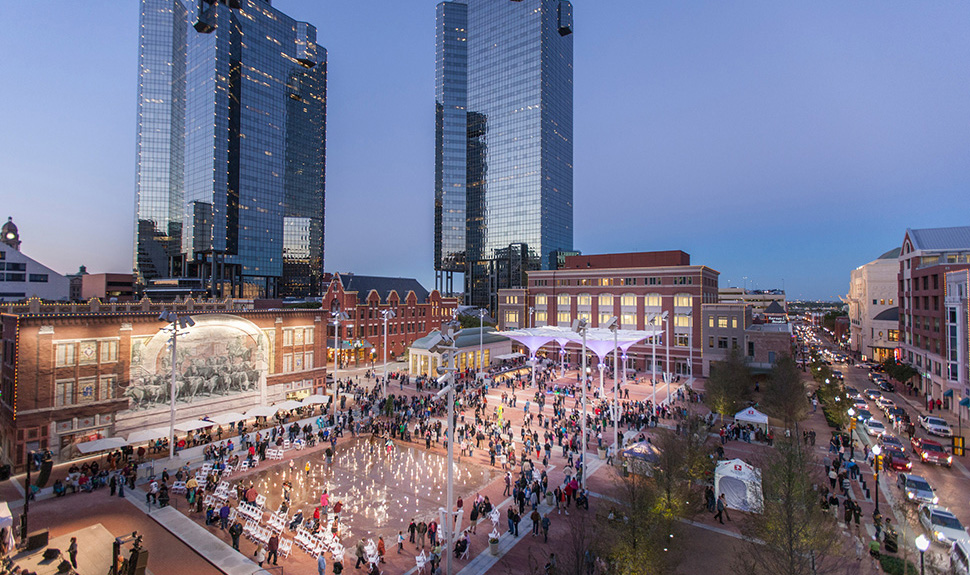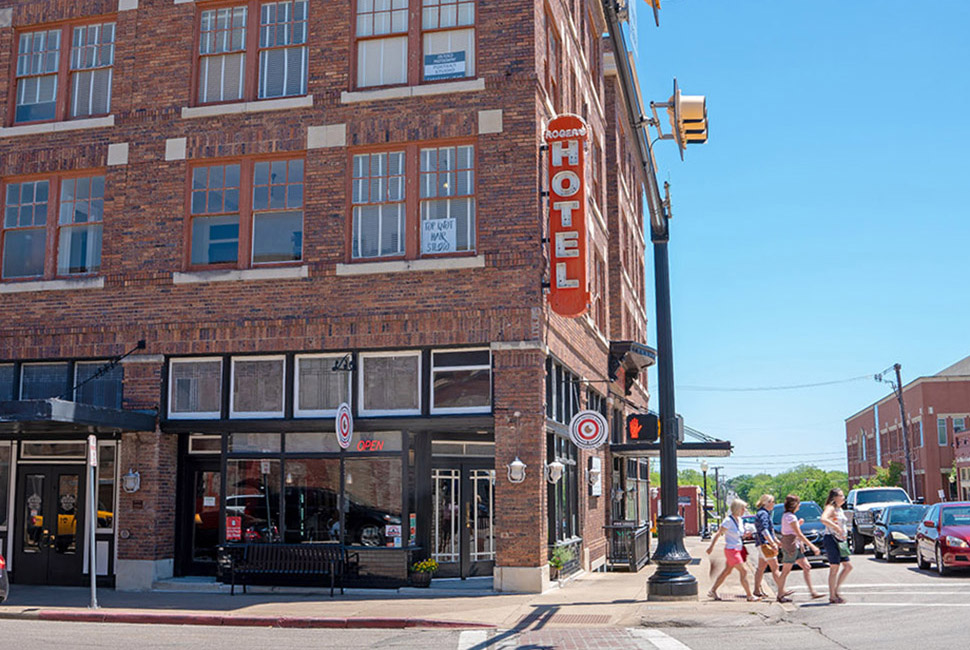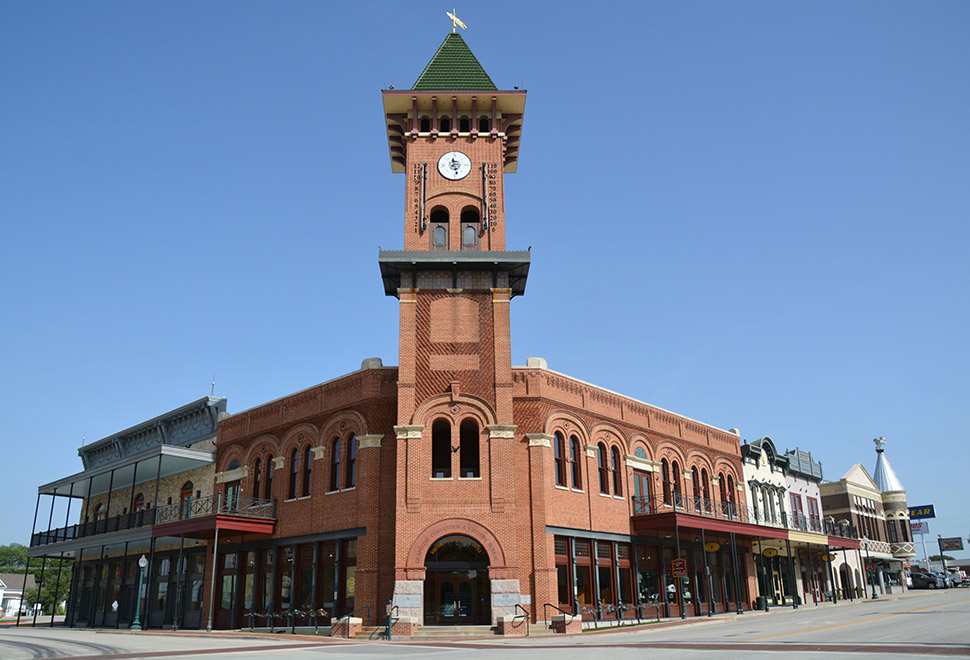All across North Texas, cities and towns have embraced historic redevelopment as a way to bring in new businesses, new residents, and tourist dollars.
Old, sometimes ramshackle, buildings become bustling shops and restaurants. Aged hotels find new life and new guests to fill their rooms. Once empty streets teem with pedestrians window shopping or just sightseeing.
You’ll find historic redevelopment not just in Dallas and Fort Worth, but in cities like Grapevine, Arlington, and Waxahachie, too. Here’s a look at what developers in some of those cities have done to put a new face on once-ignored properties.
READ NEXT Historic Preservation: How Bringing New Life to Old Buildings Reaps Rewards

[Photo: Courtesy Visit Fort Worth]
Sundance Square
The district became an example of how private citizens, businesspeople, and the city could work together to improve their hometown—so much so that it now is recognized as one of the nation’s top downtown areas. Fort Worth’s landmark Sundance Square—named for Butch Cassidy’s famed outlaw partner, the Sundance Kid—dates back to 1979 when Bass Brothers Enterprises began buying buildings and land in the downtown area of the city. Urban decay had set in, but the brothers transformed the old historic buildings through adaptive rehabilitation and built new ones. Residential, retail, restaurants, and nightclubs came. Open areas blossomed into gathering points for city residents.
Fun Facts:
- Sundance Square occupies 36 blocks
- 44 buildings are owned by Sundance Square
- 100% renewable energy is used to power the district

[Photo: Rebeca Posadas-Nava]
Downtown Waxahachie
To understand how downtown Waxahachie is flourishing, you only need to look at the numbers. The number of restaurants has doubled since 2015 from 12 to 24. The number of residential units has increased from 20 to 40, according to The Waxahachie Sun. Starting in 2014, developers like Amanda Moreno-Lake and her husband, Jim Lake Jr., have bought buildings in the downtown area, renovated them, and set the city in Ellis County on a path to renewed prosperity.
Fun Facts:
- 120+ businesses in a 16-block area.
- The ROGERS hotel in downtown Waxahachie was built 106 years ago. Now it’s also home to retail, restaurants, and office space.

[Photo: Grapevine CVB]
Grapevine

The Grapevine Vintage Railroad is a longtime fixture. The city also is a hub for the new Trinity Railway Express. [Photo: Grapevine CVB]
Few North Texas cities embraced their history as early as the Tarrant County community of Grapevine, where its historic downtown district feels like a walk through time.
The city has nurtured a walkable, history-laden district filled with retail, restaurants, and residential in a mix of old, redeveloped structures and newly constructed buildings. There are art galleries, live entertainment venues, and wine-tasting rooms. The city is also home to the Gaylord Texan Resort and the Great Wolf Lodge, which draw in thousands of visitors a year.
Fun Fact:
- 50 buildings in the downtown area of Grapevine have historic significance
Timeline:
- 1844 — Grapevine established, making it the oldest community in Tarrant County
- 1888 — The Cotton Belt rail line arrives in Grapevine, opening it up as an agricultural trade center
- 1974 — Dallas Fort Worth International Airport opens nearby, spurring population growth for the city

[Photo: Michael Samples]
Urban Union in Arlington
What do you do with a bunch of former industrial buildings languishing near the heart of your city?
In Arlington, you create Urban Union, a walkable, mixed-use district along Front Street, south of Arlington’s Entertainment District.
Since the start of construction in 2014, Arlington-based Dodson Cos. has transformed a hodgepodge of old, rundown industrial buildings spread across several blocks by renovating the aging structures and luring such companies as Legal Draft Beer Co., Sugar Bee Sweets Bakery, Cartel Taco Bar, and The Tipsy Oak Ice House, to name a few.
“We certainly took inspiration from places I like to hang out,” Dodson Cos. President and Managing Partner Ryan Dodson told KXAS-TV earlier this year. “I love Bishop Arts. I love West 7th. I love Trinity Groves. So, in going to these spaces and hanging out there on the weekends and the evenings, why not Arlington? Why can’t this area be something extremely cool and fun? And I think we’ve proven, to a certain extent, that it is and has that capacity.”
The company has plans to expand the project, with Phase Two scheduled for completion in 2020.
Fun Facts:
- 7 acres in the infill site
- 8 buildings so far
- 70,000 square feet of space in the buildings
![]()
Get on the list.
Dallas Innovates, every day.
Sign up to keep your eye on what’s new and next in Dallas-Fort Worth, every day.
































